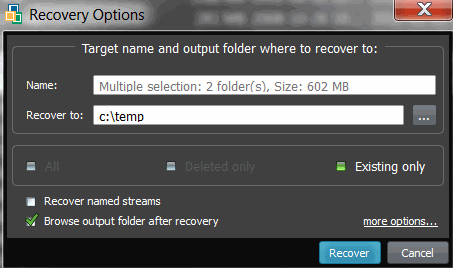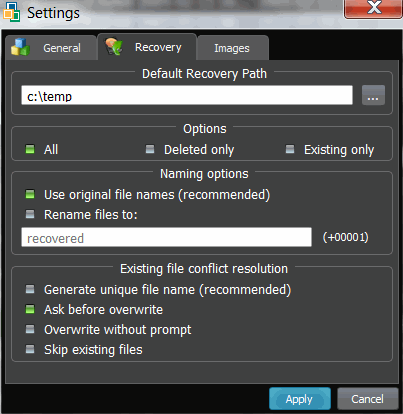Restore Deleted folder
You can distinguish deleted folders from existing folders by the icons:
- Yellow icons show existing folders
- Grey icons show deleted folders
Important
For the safety reasons, Active@ File Recovery warns you if you are trying to write the
restored file back onto the same drive. When you write a file to the same drive that contains deleted or damaged data, you may overwrite data that belongs to other deleted files or folders, or you may overwrite part of the
same file that you are trying to recover. Always restore files to another physical HDD, external USB, removable or network drive.
To restore a deleted folder:
- In Active@ File Recovery,search for deleted data and select the folder (or group of folders) to be recovered
- Launch Recovery Options dialog using one of the following methods:
- Click Recover button on the toolbar:

- Right-click the file, and then choose Recover from
the context menu
- Press Ctrl+R key combination

To give a name, you may use the name that appears in the Name
field or you may type a different name. This option is only available if selected the only one folder- To recover the to a specified location, in the Recover to field, you may type a different path or click the ellipsis button (...) and browse to a recovery folder location
- If you selected several folders, you have an option of filtering them for the recovery process:
to recover All selected folders, Deleted only or Existing only folders
- You have an option of recovering named streams attached to a file on NTFS volume.This includes, for example, Music ratings and album info, Document Author and properties, and so on... These streams will only be recovered and attached to a file when recovering target is an NTFS volume (FAT/exFAT do not support named streams)
- When you selected and want to recover files detected by their signatures, option Organize by file meta-data is available. If you turn on this option all selected files will be sorted and
placed to subdirectories using specified column order and folder depth.
For example, with default options MP3 music files will be displayed and recovered by Artist then by Album , and files will be named using Title attribute. This allows, for example, organizing pictures by Camera Model, and inside the particular Camera Model organize pictures by the date when these pictures have been taken. If this option is turned off — all selected files will be recovered as a flat list of files located in one folder
- Option Browse output folder after recovery will open Windows Explorer and display
the recovered items after recovery process is complete
- Extended recovery configuration options are available when clicking more options... link at bottom:

- Naming options: whether to use original file names, or to generate unique file names for each file being recovered
- Conflict resolution: what to do when file being recovered already exists in the target folder (name duplicate detected)
- Click Recover
After the recovery process is complete, make sure that the results are
correct by verifying the contents of files. In some cases,
a file cannot be reliably restored because its contents or a part of
it has been overwritten.
See Also
Restoring a Deleted File


